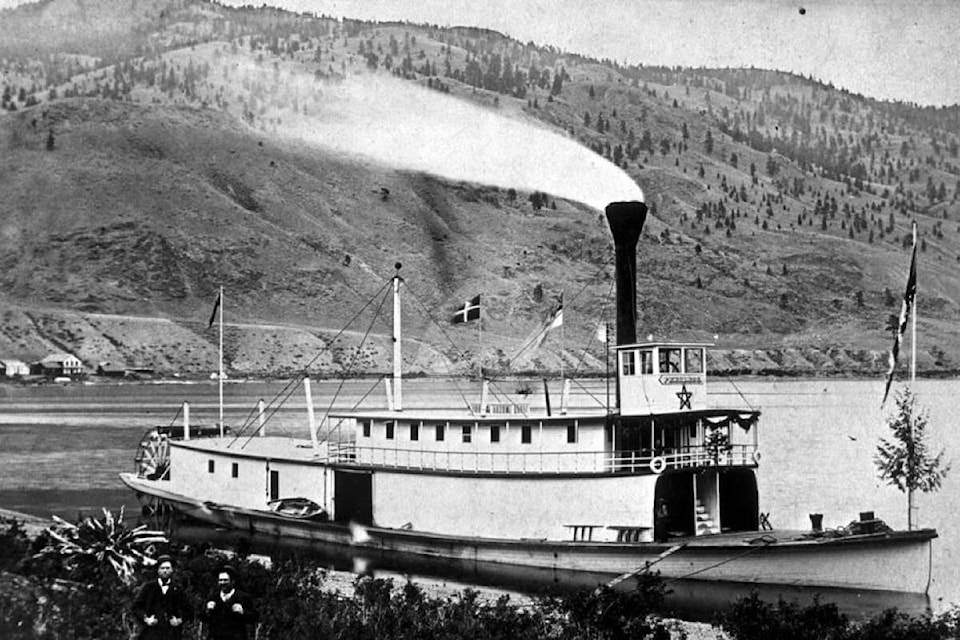The discovery of gold on the Fraser River in 1858 triggered an avalanche of would-be gold-seekers to the hastily-anointed Crown Colony of British Columbia, and on the principle of “where there is some gold, there must be more,” many of them fanned out across the territory, searching for new deposits. The rich goldfields in the Cariboo are the most famous, but there were other finds, many of them little more than (sorry) flashes in the pan.
One of these was a find near the Big Bend of the Columbia River, about 45 miles from the head of Shuswap Lake, in the early 1860s. As word spread, miners who had had little or no luck in the Cariboo headed east to the new camps that had been set up in the area. Some way of getting supplies to the camps was needed, and Kamloops Lake, the South Thompson River, and the lakes of the Shuswap were seen as a convenient network for steamboats. Supplies could be brought north along the newly-built Cariboo Waggon Road and east to Savona’s Ferry at the west end of Kamloops Lake, then be taken by boat to less than 50 miles from the Big Bend camps.
Thus it was that the colonial government offered a subsidy of $400 to anyone who would undertake to provide regular steamboat service from Savona’s Ferry eastward. The Hudson’s Bay Company got the contract, and in early 1866 James Trahey — a boat-builder from Victoria — headed to Savona’s Ferry along with a number of shipwrights. On May 27, 1866 — two months after Trahey and company arrived — the stern-wheeler Marten arrived at Seymour “city”, where it was greeted with cheers and champagne.
Unfortunately, the Big Bar strike ended up being a bust, and the mines were abandoned after one season. Steamboats along the South Thompson became a thing of the past, but they continued to ply the waters of Kamloops Lake between Savona’s Ferry and Kamloops itself as a valuable link to the Waggon Road, especially during the building of the Canadian Pacific Railway. The Peerless, a paddlewheeler, was launched at Kamloops in November 1880 to capitalize on this building, and was a regular sight at Savona’s Ferry and on the lake (she was also, as this series has documented, the only boat to make it from Savona to Spences Bridge and back again, in a memorable, never-to-be-repeated voyage in June 1881).
In the absence of the railway, which would not be completed until 1885, boats were a reliable, if not exactly speedy, way of getting from one end of the lake to the other, especially when compared to the overland alternative. Just how taxing that journey along Kamloops Lake by boat and road could be can be judged by the account given by The Revd. George Munro Grant when, in 1872, he accompanied Sandford Fleming on his expedition to find the best route for the promised rail line. In his 1873 account of the journey, Ocean to Ocean, Grant writes that the party left Kamloops at 8 a.m. on Monday, Sept. 30, 1872 to meet the paymaster of the Canadian Pacific Railway at either Cache Creek (50 miles from Kamloops) or Ashcroft (now Ashcroft Manor), some six miles further on:
“The order for the day was to row down twenty-five miles to Savona’s ferry at the foot of Kamloops Lake, and there take horses to Ashcroft. This plan would both ease the horses, and enable the Chief [Fleming] to examine a bluff on the south side of the lake, that had been represented as a formidable obstacle to the Railway line projected along the Thompson.
“A head wind springing up soon after, our rate of progress was slow… While rounding the great bluff on the south side of the Lake, the wind — which generally blows directly either up or down stream — blew so freshly up that the boat made little or no headway. We landed at midday to eat a cold lunch, resolving to take the horses if they could be seen on the other side of the bluff.
“They waited for us in a little cove beyond the bluff, nine miles from the ferry. We gladly mounted into the saddle again and in an hour and a half reached the end of the lake. Ferrying across, a council was held at Savona’s to decide what was to be done. It would be sunset before refreshment could be taken; and it looked a little Dick Turpin-ish to start at such an hour for a thirty mile ride over a new road in a cloudy moonless night. Learning, however, that the Governor [Clement Cornwall, owner of Ashcroft Manor] had been on his way to Kamloops to meet us, but had turned back to Ashcroft on hearing that we would probably be there to-night, our usual word ‘Vorwärts’ was given. A jolly-looking Boniface and Mrs. Boniface hurried up a capital supper of Kamloops beef and vegetables, coffee and cake… At 6 o’clock we were in the saddle. Four hours after we reached Cache Creek … and reached Ashcroft Hotel [the roadhouse at what is now Ashcroft Manor] at 11 o’clock.” (For those keeping score at home, it took Fleming’s party 15 hours by boat and horse to get from Kamloops to Ashcroft, a journey that today takes about one hour.)
Alas, the completion of the CPR was the death knell of the Kamloops Lake steamboats. However, Savona remained, although the ferry which was still part of its name was about to get a very serious rival which, in a slightly different form, is still with us today.
Next time: The Canadian Pacific Railway comes to town.
editorial@accjournal.ca
Like us on Facebook and follow us on Twitter
